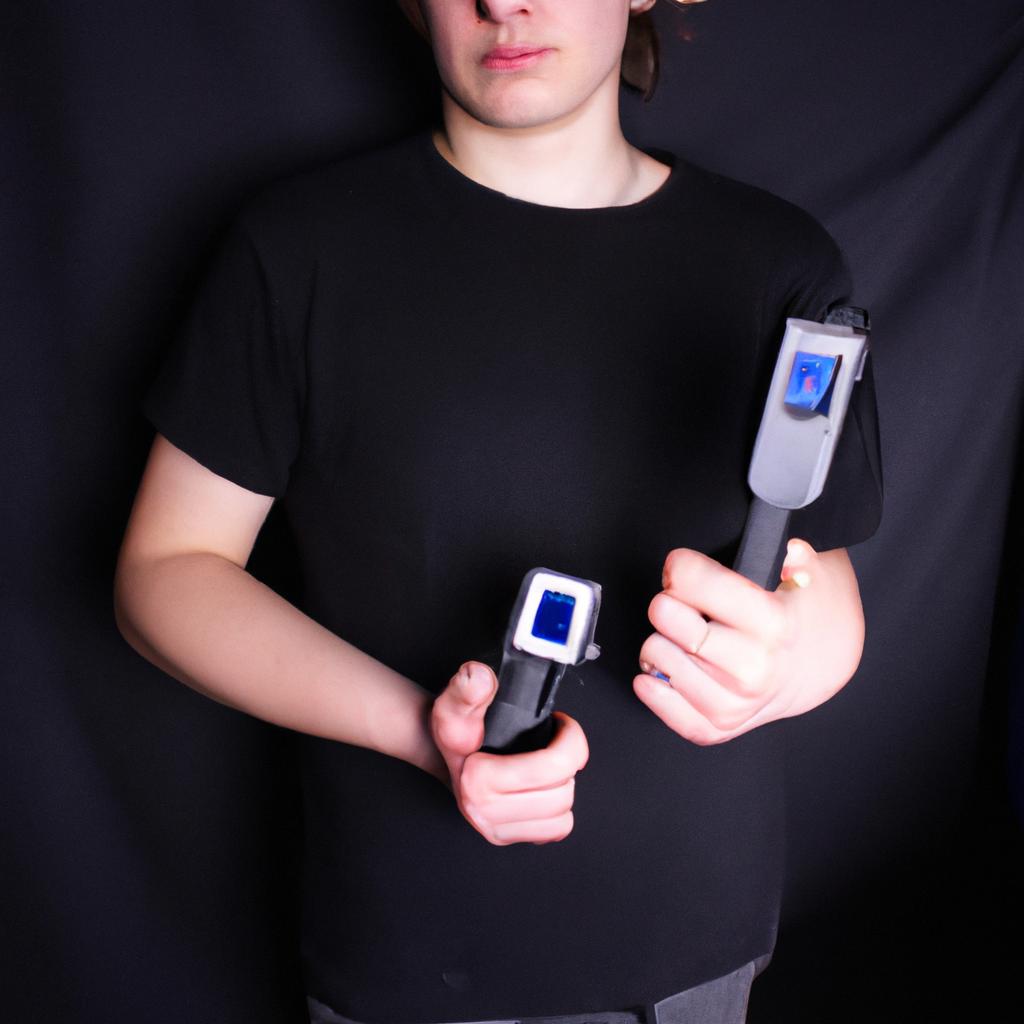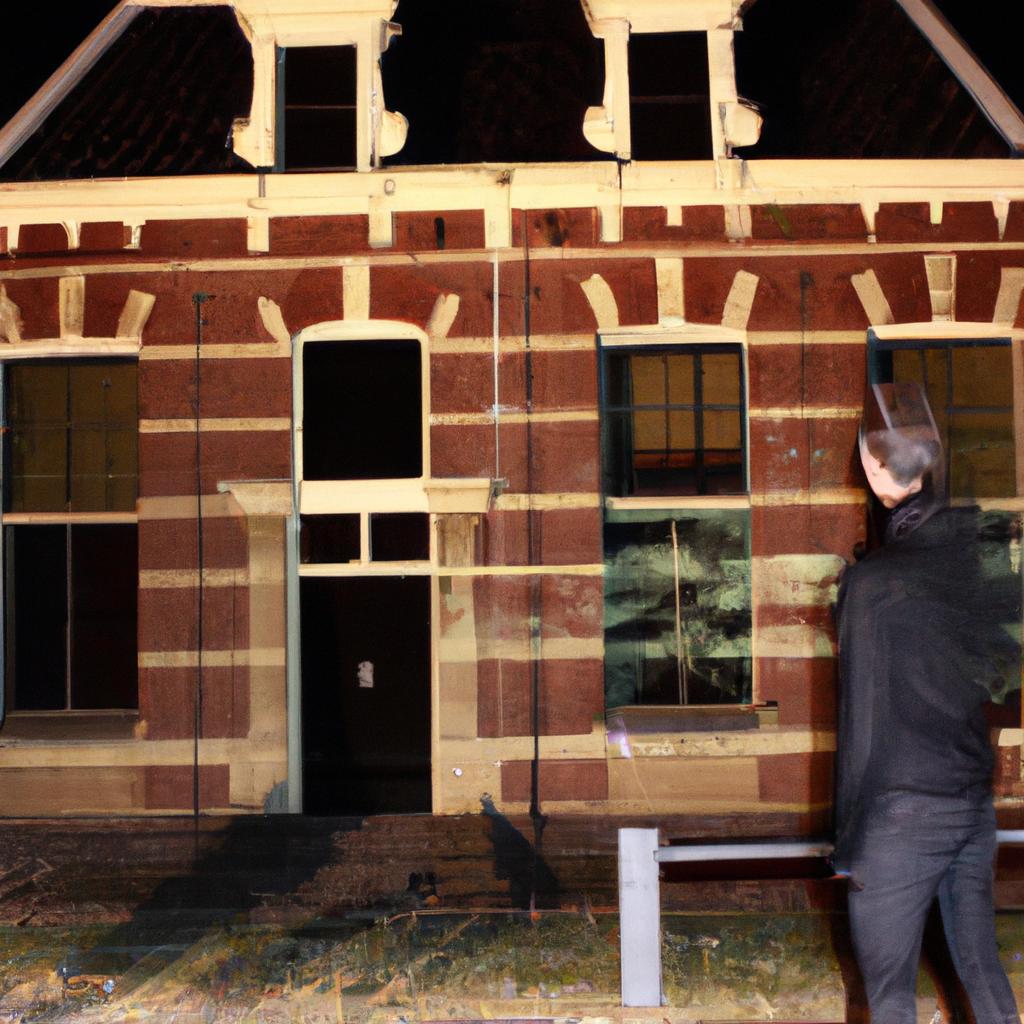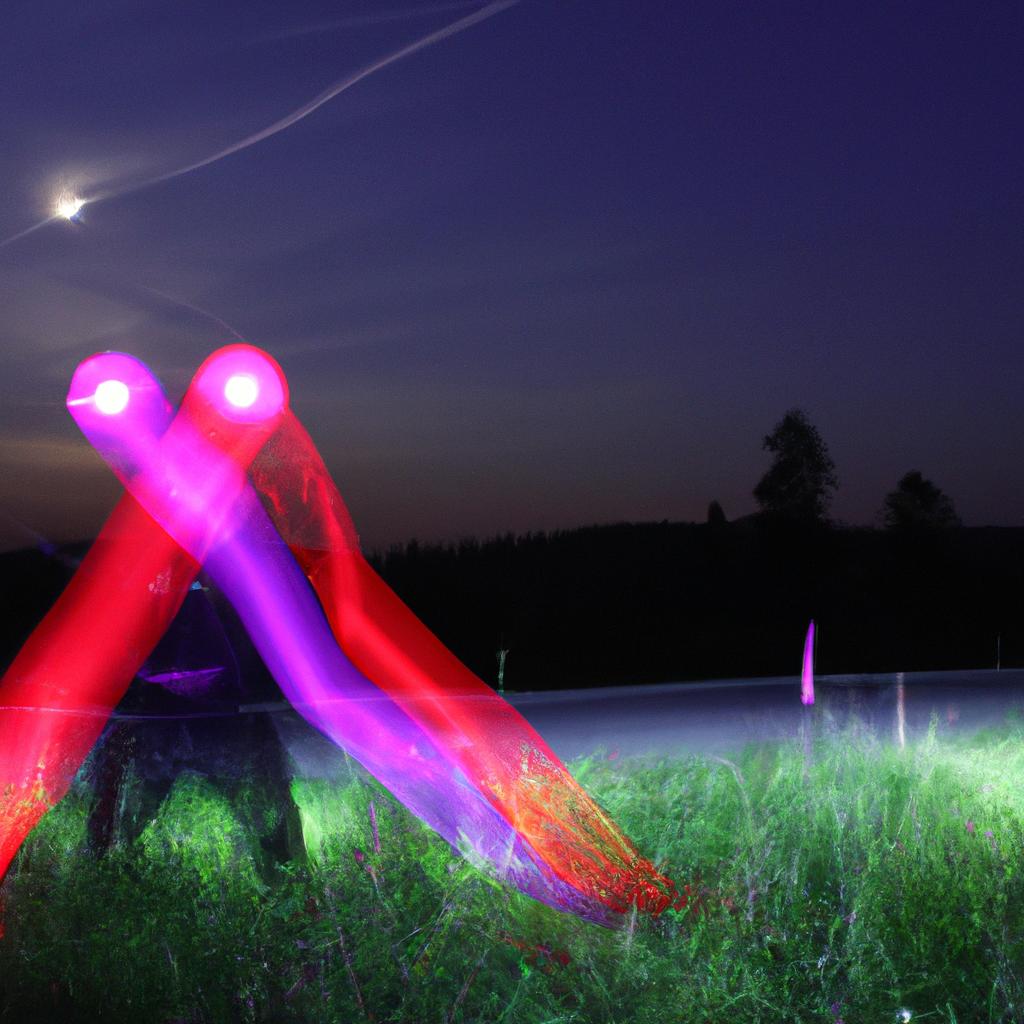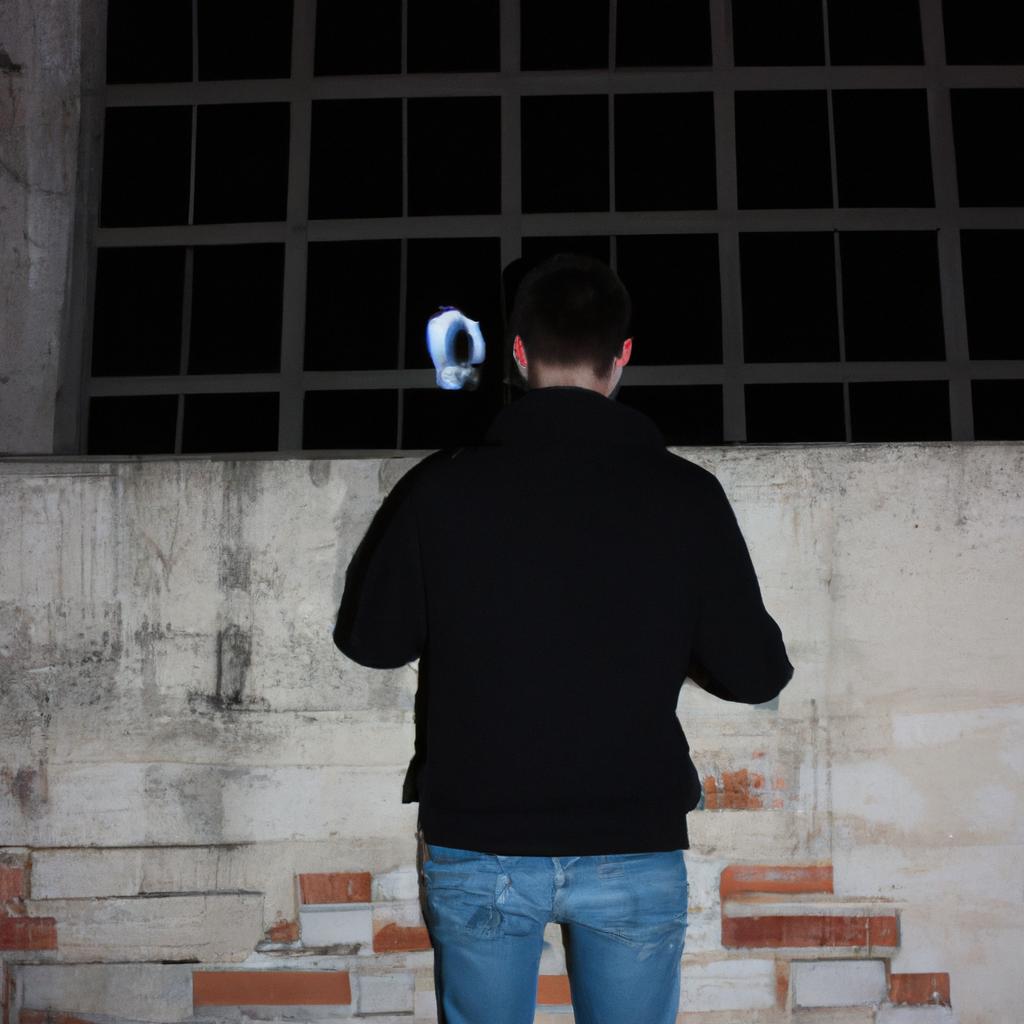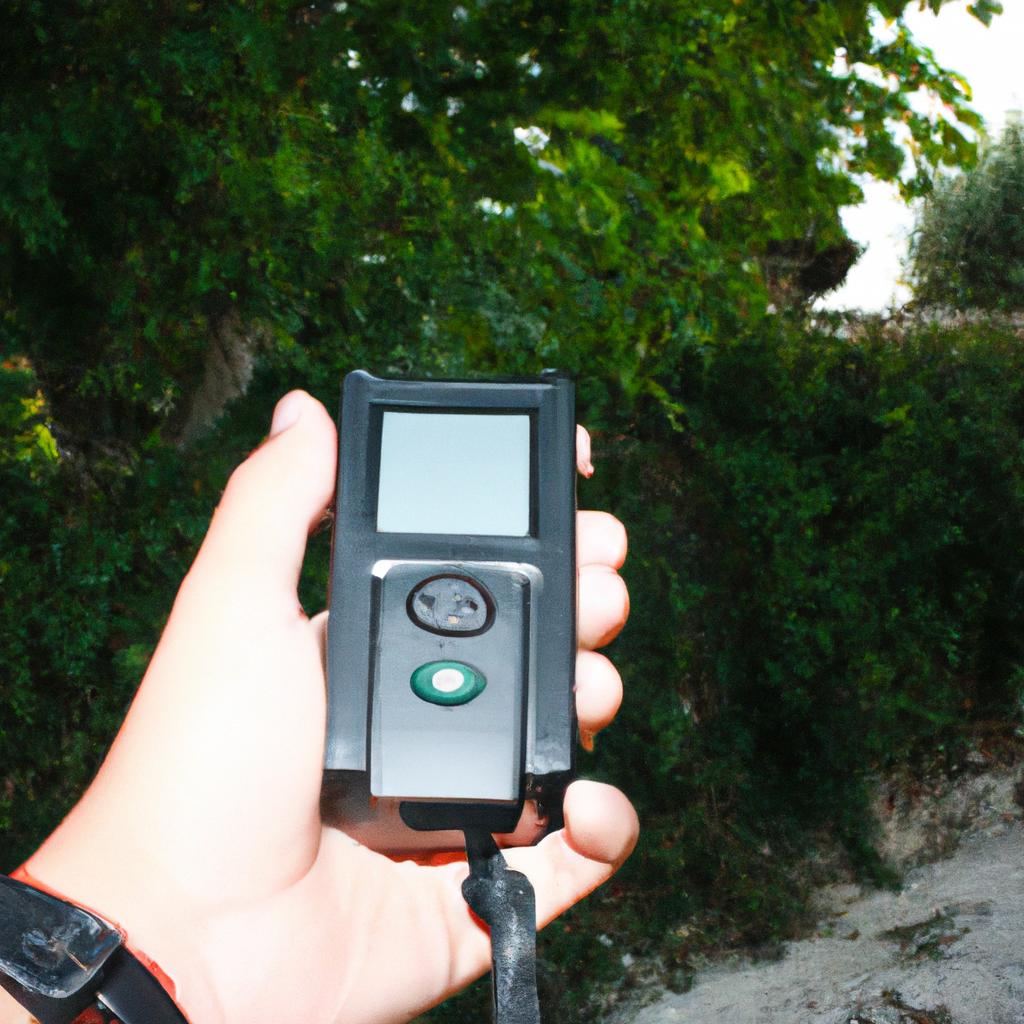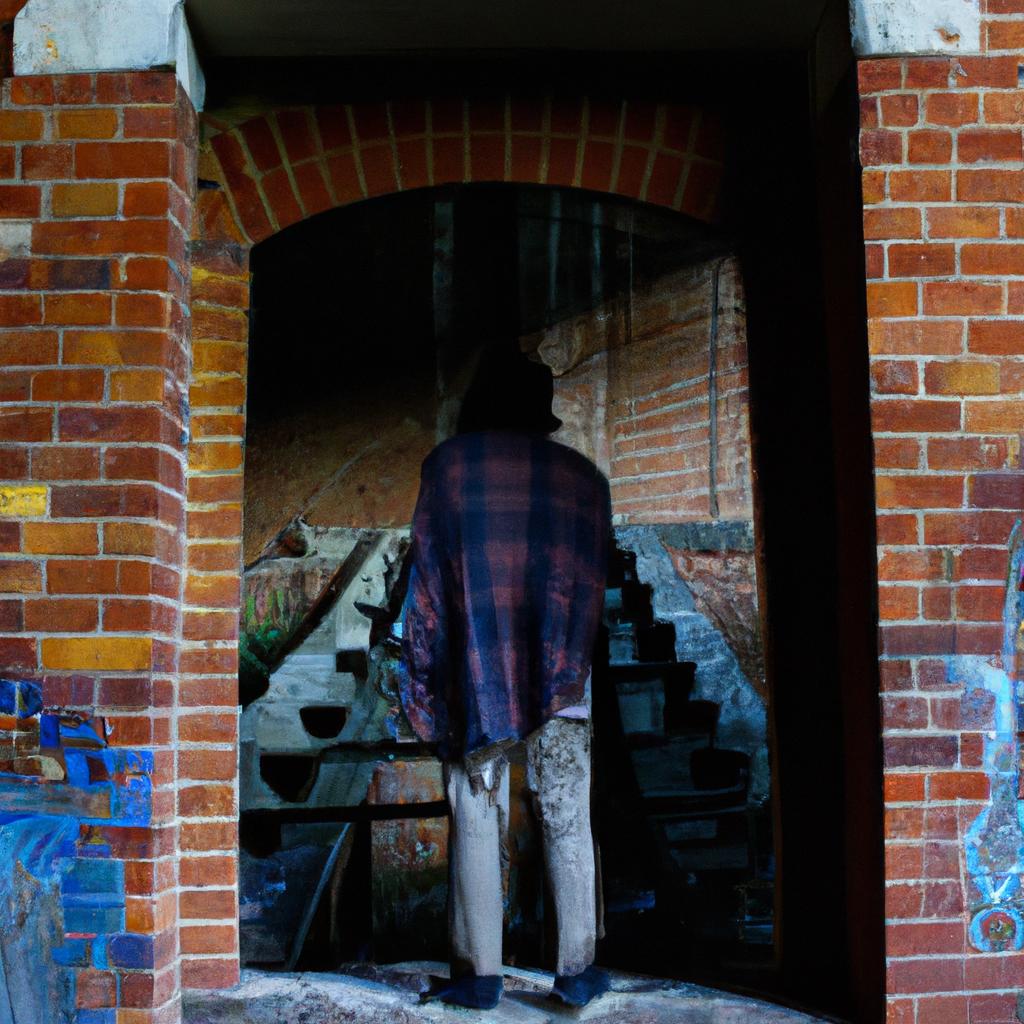Ghosts Unveiled: A Paranormal Insight

Ghosts have long been a subject of intrigue and fascination in various cultures and societies throughout history. The phenomenon of ghostly apparitions has captivated the human imagination, sparking countless debates and discussions among scholars, scientists, and believers alike. Whether these spectral entities exist outside the realm of our perception or are mere figments of our collective subconscious remains an enigma that continues to elude concrete understanding. This article titled “Ghosts Unveiled: A Paranormal Insight” aims to delve into the world of ghosts from an academic standpoint, examining evidence, theories, and experiences surrounding this mysterious phenomena.
Consider for instance a case study involving a reportedly haunted house located in a small town on the outskirts of London. In this particular scenario, numerous sightings of ethereal figures roaming through dimly lit corridors have been reported by residents over several decades. Witnesses claim to have experienced chilling drafts with no discernible source, objects moving without apparent cause, and inexplicable sounds echoing through empty rooms. These accounts serve as just one example showcasing humanity’s enduring fascination with the paranormal. Through careful analysis and exploration of such instances, we aim to shed light on the realm of ghosts and contribute to the ongoing discourse regarding their existence or lack thereof.
Approaching this topic with scientific rigor Approaching this topic with scientific rigor involves examining the claims and experiences surrounding ghosts using empirical evidence, logical reasoning, and critical analysis. It requires employing various research methodologies such as controlled experiments, systematic observations, and statistical analyses to investigate the phenomena associated with ghostly apparitions.
One avenue of exploration is studying eyewitness testimonies and personal accounts of ghost encounters. By interviewing witnesses, documenting their experiences in detail, and cross-referencing them with other reported incidents, researchers can identify commonalities or patterns that may provide insights into the nature of these alleged supernatural occurrences.
Additionally, technological advancements have allowed for the use of equipment such as electromagnetic field detectors, thermal cameras, audio recording devices, and motion sensors to capture potential paranormal activity. Analyzing the data collected from these tools can help determine if there are any anomalous readings or events that defy conventional explanations.
Furthermore, psychological factors play a significant role in understanding ghostly experiences. Researchers can investigate cognitive biases, suggestibility, hallucinations, and other psychological phenomena to comprehend why individuals perceive certain phenomena as paranormal.
Overall, approaching the study of ghosts with scientific rigor involves combining multiple disciplines such as psychology, physics, neuroscience, and anthropology to gather evidence objectively and analyze it critically. Through this approach, we aim to contribute to a more comprehensive understanding of this complex subject matter while acknowledging its inherent mystery.
The Enigma of Electronic Voice Phenomenon (EVP)
The Enigma of Electronic Voice Phenomenon (EVP)
One intriguing aspect of the paranormal world is the phenomenon known as Electronic Voice Phenomenon (EVP). EVP refers to the unexplained occurrence of voices or sounds captured on electronic devices, such as tape recorders or digital voice recorders, without any discernible source. To illustrate its enigmatic nature, let us consider a hypothetical scenario: imagine an investigator exploring an abandoned building late at night with no one else present. As they review their audio recordings later, they discover faint whispers and eerie voices that were not audible during the investigation itself.
This baffling phenomenon has fascinated paranormal enthusiasts and researchers alike for decades. The inexplicable nature of EVP raises numerous questions about its origin and validity. Is it truly evidence of communication from beyond? Or could there be logical explanations behind these ghostly whispers?
To delve deeper into this captivating topic, we will explore four key aspects related to EVP:
- History: Discover how EVP first came to public attention in the mid-20th century through pioneers like Friedrich Jürgenson and Konstantin Raudive.
- Types of Voices: Explore the different classifications of EVP voices, ranging from Class A clear voices to Class C distorted and unintelligible ones.
- Interpretation Challenges: Understand the difficulties faced by investigators when interpreting and analyzing EVP recordings due to subjective interpretation and external factors.
- Skeptical Explanations: Consider alternative explanations proposed by skeptics who argue that environmental contamination or auditory pareidolia can account for perceived EVP phenomena.
Table: Examples of Interpretation Challenges in Analyzing EVP Recordings
| Challenge | Description |
|---|---|
| Background Noise | Distinguishing between actual spirit voices and background noise can be challenging due to overlapping frequencies. |
| Subjective Bias | Personal beliefs may influence interpretations, leading investigators to hear specific words or phrases in the recordings. |
| Audio Manipulation | Unintentional audio manipulation during recording, playback, or editing can create false EVPs. |
| Cross-Language Communication | Investigators may encounter EVP messages in languages they do not understand, making interpretation problematic. |
As we explore these key aspects of Electronic Voice Phenomenon (EVP), it becomes apparent that unraveling this intriguing mystery requires critical examination and scientific rigor. By understanding its history, different types of voices encountered, interpretation challenges faced by investigators, and skeptical explanations put forth, we can navigate closer to solving the enigma behind EVP.
Transitioning seamlessly into the subsequent section about “Unraveling the Mystery Behind Poltergeist Activity,” we shift our focus from ghostly whispers captured on electronic devices to another perplexing phenomenon within the paranormal realm.
Unraveling the Mystery Behind Poltergeist Activity
Unveiling the Secrets of Electronic Voice Phenomenon (EVP)
As we delve deeper into the realm of paranormal phenomena, one intriguing enigma that has captivated investigators and skeptics alike is the phenomenon known as Electronic Voice Phenomenon (EVP). This unexplained occurrence involves capturing disembodied voices or sounds on electronic recording devices, often during investigations in allegedly haunted locations. To shed light on this mysterious phenomenon, let us explore some key aspects surrounding EVP.
Example Case: The Haunting Whispers
Imagine a group of paranormal researchers conducting an investigation at an abandoned asylum. In their pursuit to capture evidence of supernatural activity, they set up audio recorders throughout the building. Upon reviewing the recordings later, faint whispers are detected—one voice seemingly calling out for help while another utters indiscernible words. These inexplicable vocalizations spark curiosity and raise questions about the origin of these ghostly utterances.
To better understand EVP, consider the following:
- Origin: The exact source or mechanism behind EVP remains unknown; however, proponents suggest that spirits or entities from beyond our physical world communicate through manipulation of electromagnetic frequencies or white noise.
- Classification: Researchers have categorized EVP into different classes based on clarity and audibility—ranging from Class A (clear and easily understandable) to Class C (faint and difficult to decipher).
- Interpretation Challenges: Deciphering EVP messages can be subjective since individuals may interpret them differently due to variations in perception and personal biases.
- Skepticism vs Belief: Skeptics argue that EVP recordings could be attributed to random noises or auditory pareidolia—the tendency for humans to perceive meaningful patterns in ambiguous stimuli. On the other hand, believers view EVP as compelling evidence supporting communication with spirits.
Let’s now move forward in our exploration by unraveling yet another perplexing phenomenon associated with paranormal occurrences – Poltergeist Activity.
| Classifications of EVP | Description |
|---|---|
| Class A | Clear and easily understandable voices or sounds captured on recordings. |
| Class B | Less distinct than Class A, but still audible with some effort to decipher the words or phrases. |
| Class C | Faint and often require significant audio enhancement to make out any discernible messages. |
Intriguingly, EVP has been a subject of fascination in popular culture as well. From movies to television shows, this phenomenon has sparked curiosity and captivated audiences worldwide. However, amidst its allure, the enigma surrounding EVP continues to challenge both believers and skeptics alike.
By delving into real-life cases such as The Haunting Whispers, we gain insight into the captivating nature of paranormal investigations and their ability to evoke emotions ranging from awe to fear. As researchers strive to unravel the secrets behind Electronic Voice Phenomenon, they venture further into uncharted territories in pursuit of understanding the mysteries that lie beyond our grasp.
Now let us journey deeper into the realm of supernatural encounters by exploring another intriguing phenomenon – Shadow People.
Exploring the Phenomenon of Shadow People
Poltergeist activity has long fascinated and perplexed researchers in the field of paranormal phenomena. These unexplained disturbances, often characterized by objects moving or being thrown seemingly on their own, have left both scientists and skeptics questioning the nature of these occurrences. To shed light on this enigma, let us delve into one intriguing case study that exemplifies poltergeist activity.
In a small town nestled deep within the English countryside, an unassuming family began experiencing inexplicable events within their home. It started with subtle signs – doors creaking open without cause, whispers heard from empty rooms – but quickly escalated to more unsettling manifestations. Furniture would levitate off the ground, photographs would mysteriously shatter, and even physical harm befell some members of the household. This case captivated paranormal investigators who tirelessly sought logical explanations for these supernatural occurrences.
To better understand poltergeist activity, it is essential to consider several key factors:
- Emotional Turmoil: Many instances of poltergeists are believed to be connected to individuals experiencing high levels of emotional stress or trauma.
- Telekinetic Energy: The theory suggests that psychokinetic energy emanating from a person going through emotional distress can inadvertently manipulate objects in their surroundings.
- Unconscious Influence: Some researchers propose that the phenomenon may be caused by unconscious mental processes rather than external entities.
- Temporal Nature: Poltergeist disturbances tend to be episodic in nature, occurring spontaneously and then subsiding after a period of time.
As we explore further into the enigmatic world of paranormal phenomena, it becomes evident that there is still much to unravel regarding poltergeist activity. By delving deeper into cases like the one mentioned above and analyzing various theories put forth by experts in the field, we inch closer towards comprehending these inexplicable happenings.
Transitioning seamlessly from our exploration of poltergeist activity, we now turn our attention to another intriguing phenomenon that continues to bewilder researchers and skeptics alike: shadow people.
Unveiling the Secrets of Apparitions
As we delve further into the world of paranormal phenomena, it is crucial to explore the enigmatic realm of apparitions. These ghostly figures have long fascinated and perplexed researchers, with countless reports from individuals claiming to have witnessed these ethereal beings. One such account involves a haunted house in rural England, where residents reported seeing a spectral figure dressed in Victorian-era clothing wandering aimlessly through the halls.
Apparitions are unique manifestations within the supernatural spectrum and can be classified into various types based on their characteristics. Understanding these classifications can provide valuable insights into the true nature of these elusive entities:
-
Residual Hauntings: These apparitions often repeat specific actions or events from their past lives, seemingly unaware of their surroundings. They appear as if trapped in a time loop, forever reliving certain moments or emotions associated with that particular location.
-
Intelligent Hauntings: In contrast to residual hauntings, intelligent apparitions possess consciousness and interact with their environment. Witnesses report instances where spirits respond to questions or exhibit purposeful behavior, suggesting some form of awareness beyond mere repetition.
-
Poltergeists: Known for causing disturbances like objects moving inexplicably or loud noises without any visible cause, poltergeist activity is often attributed to powerful energy emanating from living individuals rather than deceased spirits themselves.
-
Crisis Apparitions: This type occurs during times of intense emotional distress or imminent danger when an individual’s spirit appears before loved ones as a warning sign or farewell gesture.
To better understand this phenomenon, let us examine a comparative analysis between different types of apparitions in terms of their characteristics and behaviors:
| Types | Characteristics | Behaviors |
|---|---|---|
| Residual | Repeats actions/events from past life | No interaction; oblivious to surroundings |
| Intelligent | Conscious and interactive | Responds to questions; purposeful behavior |
| Poltergeists | Causes disturbances without visible cause | Object movement; loud noises |
| Crisis | Occurs during emotional distress/danger | Warning sign or farewell gesture |
The study of apparitions continues to captivate researchers worldwide, as they strive to unravel the mysteries surrounding these ethereal entities. By examining various case studies, conducting controlled experiments, and utilizing advanced technology, we inch closer to deciphering their true nature.
With a deeper understanding of apparitions now established, let us embark on an exploration into the thrilling world of ghost hunting and its scientific methodologies.
The Thrill and Science of Ghost Hunting
As we delve further into the enigmatic world of apparitions, it becomes increasingly clear that these ethereal beings continue to captivate our imagination. To shed light on this phenomenon, let us examine a hypothetical case study: Sarah, a resident of an old Victorian house, claims to have witnessed spectral figures roaming the corridors late at night. This eerie encounter serves as a testament to the enduring allure and mystery surrounding ghosts.
To better understand the intricacies of these supernatural occurrences, several key factors must be taken into consideration:
-
Historical Context:
- Ghost sightings often coincide with locations imbued with rich histories.
- The presence of unresolved past events may contribute to heightened paranormal activity.
-
Perception and Sensory Experience:
- Individuals report varying degrees of sensory stimuli during ghostly encounters.
- These experiences can range from auditory phenomena such as whispers or footsteps, to visual manifestations like shadowy figures or full-bodied apparitions.
-
Psychological Factors:
- Personal beliefs and cultural influences play a significant role in shaping one’s perception of ghosts.
- Emotional states, such as fear or curiosity, can influence how individuals interpret their ghostly encounters.
-
Scientific Exploration:
- Researchers employ various methods for investigating paranormal phenomena.
- Technological advancements allow for the capture of electronic voice phenomena (EVP), thermal imaging, and other forms of evidence-gathering during investigations.
Through careful analysis and research, professionals in the field strive to demystify the nature of apparitions while recognizing that some aspects remain elusive. By harnessing technological tools and embracing historical context alongside personal experiences, we inch closer towards unraveling the secrets behind these spectral entities.
Journeying into the World of Haunted Locations
Unveiling the Existence: Unearthing Eerie Encounters
Imagine yourself standing in an abandoned asylum, dimly lit by moonlight filtering through broken windows. As you cautiously navigate through the eerie corridors, a chilling breeze brushes against your skin. You can’t help but wonder if there is something unseen lurking in the shadows. This chilling scenario represents just one of countless encounters that ghost hunters have experienced while exploring haunted locations around the world.
Ghost hunting has become a popular phenomenon, attracting enthusiasts who seek to unravel and document paranormal activity. These investigations blend elements of thrill-seeking with scientific methodology to explore the existence of ghosts. By employing various techniques and tools such as electromagnetic field detectors (EMF), digital voice recorders, and thermal cameras, researchers aim to capture evidence that supports claims of supernatural presence.
In their quest for answers, paranormal investigators approach their work with meticulous attention to detail and objectivity. They rely on established protocols to ensure accurate data collection and analysis, adhering to ethical standards within the field. Here are some key aspects that contribute to successful Ghost Hunting:
- Research: Before embarking on an investigation, thorough research is essential. Investigators delve into historical records, folklore, eyewitness accounts, and any available documentation pertaining to reported hauntings at a specific location.
- Equipment: Utilizing specialized equipment assists in capturing unexplained phenomena during investigations. From EMF meters that measure fluctuations in electromagnetic fields believed to be associated with spirits’ presence, to spirit boxes used for real-time communication attempts with entities from beyond.
- Collaboration: Ghost hunting often involves teamwork among like-minded individuals who share a passion for uncovering mysterious occurrences. Collaborating helps pool resources, knowledge, and skills necessary for comprehensive investigations.
- Analysis: Once evidence is collected during an investigation — whether it’s audio recordings or visual anomalies captured on camera — careful analysis becomes paramount. Researchers examine each piece of evidence meticulously, employing scientific methods to determine its authenticity and potential connection with the paranormal.
To gain a deeper understanding of ghost hunting practices, let’s explore haunted locations that have captured the attention of enthusiasts worldwide. From legendary castles to abandoned hospitals, these sites hold an undeniable allure for those seeking encounters with the supernatural. Through their explorations and investigations in such locales, researchers aim to shed light on the inexplicable phenomena that continue to perplex us all.
As we transition into our next section, “The Uncanny Connection: Spirits and EVP,” prepare yourself for an exploration of electronic voice phenomena (EVP) – capturing voices from beyond using audio recording devices. It is through EVP recordings that investigators hope to bridge the gap between our world and the realm of spirits, unearthing messages from entities believed to inhabit haunted locations. But before diving into this fascinating aspect of ghost hunting, it is crucial to understand how technology plays a pivotal role in connecting with what lies beyond our mortal existence.
The Uncanny Connection: Spirits and EVP
The Uncanny Connection: Spirits and EVP
Having explored the intriguing world of haunted locations, let us now delve into the uncanny connection between spirits and Electronic Voice Phenomenon (EVP). To illustrate this phenomenon, consider a hypothetical scenario where paranormal investigators set up audio recording equipment in an allegedly haunted house. As they review their recordings later, they discover mysterious voices that were not audible to them during their investigation.
This eerie occurrence highlights the concept of EVP, which refers to the alleged capture of disembodied voices or sounds on electronic devices without any discernible source. While skeptics attribute these phenomena to environmental factors or pareidolia—our tendency to perceive meaningful patterns within random stimuli—enthusiasts argue that EVP serves as compelling evidence of spirit communication beyond our ordinary sensory perception.
To better understand this fascinating subject, it is essential to explore some key aspects related to spirits and EVP:
-
Types of EVP: These manifestations can be classified into different categories based on their clarity and intensity, ranging from Class A (easily understandable) to Class C (faint and often requiring amplification).
-
Methods for Capturing EVP: Paranormal investigators employ various techniques such as using digital voice recorders or radio frequency sweep devices known as “ghost boxes” to capture potential spirit voices.
-
Analysis Challenges: Analyzing EVP recordings presents its own set of challenges due to background noise contamination and subjective interpretation by individuals involved in the investigation process.
-
Debunking Efforts: Skeptics have attempted to debunk EVP through scientific explanations like stray electromagnetic interference or radio signals bleeding into audio recordings.
Exploring these aspects will provide deeper insights into how spirits may communicate with us through cryptic messages embedded within electronic frequencies. The notion of capturing otherworldly voices brings forth profound questions about life after death and the existence of dimensions beyond our current understanding.
Intriguingly enough, unexplained phenomena extend beyond EVP, leading us to the next section: “Unexplained Disturbances: Poltergeist Activity Explored.” As we delve into this intriguing subject matter, prepare to uncover the unsettling nature of poltergeists and their disruptive influence on physical surroundings.
Unexplained Disturbances: Poltergeist Activity Explored
In the realm of paranormal investigation, one phenomenon that has captivated researchers and skeptics alike is Electronic Voice Phenomenon (EVP). This intriguing occurrence involves capturing voices or sounds from unknown sources on audio recordings, leading to a deeper understanding of spirits’ ability to communicate with the living. One compelling example that showcases the power of EVP is the case study of the Winchester Mystery House in California.
The Winchester Mystery House, known for its eerie allure and mysterious history, became a focal point for paranormal investigators seeking evidence of supernatural activity. During numerous investigations, EVP sessions were conducted in various areas of the house. In one instance, an investigator asked if any spirits present would like to make their presence known. To everyone’s astonishment, a chilling voice responded on the recording, stating clearly, “I am here.” This spine-tingling encounter not only provided concrete evidence of otherworldly communication but also raised questions about the nature and intentions of these spectral beings.
To further understand EVP phenomena and its implications within paranormal research, it is essential to examine some key points:
- Audio Manipulation: Researchers employ advanced audio analysis techniques to enhance captured EVPs by clarifying indistinct voices or removing background noise.
- Emotional Resonance: Many EVPs contain emotional content such as whispers, cries, or laughter. These evocative elements elicit powerful reactions from listeners.
- Multilingual Communication: It is not uncommon for EVPs to occur in different languages beyond those spoken by participants during investigations.
- Debunking Skepticism: Skeptical viewpoints often attribute EVP occurrences solely to auditory pareidolia or random interference; however, multiple controlled experiments have ruled out these explanations.
This table illustrates common types of EVP manifestations encountered during investigations:
| Type | Description |
|---|---|
| Class A | Clear and easily understandable EVP recordings. |
| Class B | Less distinct than Class A, requiring careful analysis. |
| Class C | Faint and often require amplification for audibility. |
| Whispering Voices | Soft, hushed voices that project an eerie quality. |
| Disembodied Sounds | Noises like footsteps or objects being moved without cause |
In light of the aforementioned evidence and research, it becomes evident that Electronic Voice Phenomenon represents a significant area within paranormal investigation. The ability to capture these otherworldly messages offers a glimpse into the unknown, confirming the existence of spirits and their capacity to interact with our world.
As we delve further into the realm of unexplained phenomena, let us now turn our attention to the intriguing occurrences surrounding poltergeist activity and the unsettling disturbances they bring forth.
Unseen Entities: Understanding Shadow People
Poltergeist activity, characterized by inexplicable disturbances and mischievous behavior attributed to unseen forces, has long fascinated both skeptics and believers of the paranormal. One example that sheds light on this phenomenon is the Enfield Poltergeist case in North London during the late 1970s. This notorious haunting involved a young girl named Janet Hodgson who claimed to be possessed by a malevolent spirit, leading to objects levitating, furniture moving on its own, and unexplainable knocking sounds.
To better understand poltergeist activity, it is crucial to explore some key factors associated with these eerie occurrences:
- Emotional Turmoil: Poltergeists are often believed to manifest in environments where there is emotional turmoil or psychological stress present. The intense emotions experienced by individuals can inadvertently provide an outlet for such phenomena to occur.
- Telekinetic Energy: Many researchers propose that poltergeist activity stems from telekinesis – the ability to move objects using only mental energy. In cases where this theory holds true, it suggests that certain individuals possess latent psychic abilities that unconsciously trigger these physical manifestations.
- Temporal Nature: Unlike traditional hauntings which may persist over extended periods, poltergeist activity tends to be temporary and usually subsides after a few months or years. This temporal nature further adds intrigue as it raises questions about the underlying causes and potential triggers.
- Paranormal Residue: Some investigators believe that poltergeists leave behind residual energies at their haunt locations even after they have ceased their activities. These lingering energies may contribute to subsequent reports of supernatural encounters or disturbances.
Emotional distress, telekinetic energy, transient occurrences, and residual effects form just a fraction of what contributes to the enigma surrounding poltergeist activity. By delving deeper into these aspects while examining notable cases like the Enfield Poltergeist, we can continue to unravel the mysteries that lie within these unexplained disturbances.
Beyond the Veil: Investigating Apparitions
Unseen Entities: Understanding Shadow People
In our exploration of the paranormal, we now turn our attention to a peculiar phenomenon known as shadow people. These elusive figures have captured the fascination of many researchers and witnesses alike. To shed light on this enigmatic topic, let us delve into their characteristics, encounters with them, and potential explanations.
One striking example that illustrates the eerie nature of shadow people involves a couple residing in an old Victorian house. Late one night, they found themselves awakened by a sense of unease permeating their bedroom. As they opened their eyes, they were startled to witness a tall, dark figure standing at the foot of their bed. Its form was indistinct yet undeniably human-like, casting an ominous silhouette against the moonlit room before vanishing into thin air. This encounter left them bewildered and questioning what they had just witnessed.
When examining various accounts such as this one, several commonalities emerge among shadow people encounters:
- Sudden appearances: Witnesses often report seeing these entities out of nowhere, seemingly materializing in front of them.
- Silent observers: Shadow people are frequently described as observing silently from corners or doorways without making any discernible sounds.
- Intense emotions: Individuals who come face-to-face with shadow people often experience intense feelings of fear or dread.
- Elusiveness: Attempting to interact or engage with these entities appears futile as they swiftly vanish when approached.
To further understand the possible origins of shadow people phenomena, theories range from psychological explanations to supernatural interpretations. Some propose that these apparitions could be manifestations of repressed fears or anxieties projected onto the external world. Others suggest that shadow people might exist on different planes of existence beyond our comprehension—a glimpse into dimensions parallel to our own reality.
As we continue unraveling the mysteries surrounding ghostly phenomena, it is essential to explore not only individual cases but also patterns and similarities that arise from these encounters.
Emotional Impact:
- Fear: The sudden appearance and eerie nature of Shadow People can induce a strong sense of fear in witnesses.
- Curiosity: Unanswered questions about the origin and purpose of these entities evoke curiosity and intrigue.
- Dread: The intense emotions experienced during encounters with shadow people often leave individuals feeling uneasy or apprehensive.
- Intrigue: The mysterious nature of shadow people elicits a deep fascination for those intrigued by the supernatural.
| Emotion | Description |
|---|---|
| Fear | A gripping sensation stemming from encountering shadows |
| Curiosity | An eager desire to unravel the mystery behind shadow figures |
| Dread | A lingering feeling of unease after witnessing a shadow person |
| Intrigue | Captivation arising from the enigmatic nature of shadow beings |
As we explore further realms within the realm of ghostly phenomena, it becomes imperative to employ specialized tools and techniques to conduct thorough investigations. Join us as we venture into the intriguing world of ghost hunting in the subsequent section.
[Continued in ‘Beyond the Veil: Investigating Apparitions’]
Tools and Techniques: The Art of Ghost Hunting
Building upon our exploration of apparitions, we now delve into the tools and techniques employed by ghost hunters to better understand these ethereal encounters. By utilizing a variety of specialized equipment and investigative methods, researchers aim to shed light on the mysteries that lie beyond the veil.
Tools such as electromagnetic field (EMF) detectors play a crucial role in paranormal investigations. These devices measure fluctuations in electromagnetic energy, potentially indicating the presence of otherworldly entities. For instance, consider a case where investigators noticed significant spikes in EMF readings within an allegedly haunted house. Upon further investigation, they discovered that these anomalies corresponded with reported sightings of a spectral figure, suggesting a possible correlation between high EMF levels and supernatural phenomena.
To capture visual evidence of ghosts or apparitions, ghost hunters often utilize infrared cameras. These cameras are designed to detect heat signatures invisible to the human eye. Imagine observing footage from an overnight investigation at an abandoned asylum; suddenly, wispy forms appear on screen – seemingly humanoid shapes moving through walls and disappearing into thin air. This compelling imagery serves as tangible proof for believers and skeptics alike.
In addition to equipment, various techniques have been developed over time to aid in unraveling the secrets of hauntings:
- EVP sessions (Electronic Voice Phenomenon): Recording audio during investigations allows for potential communication with spirits through captured voices not audible at the time.
- Full-spectrum photography: Using modified cameras capable of capturing ultraviolet and infrared light enables researchers to uncover hidden details undetectable under normal circumstances.
- Historical research: Examining records and accounts related to purportedly haunted locations provides context and may offer clues about specific entities or events linked to reported phenomena.
- Psychic mediums: Collaborating with individuals who claim extrasensory perception can provide unique insights into spiritual energies present within a given environment.
By employing this array of tools and techniques, seasoned ghost hunters strive towards greater understanding of what lies beyond our physical realm. As we move forward, let us now journey into the realm of haunted tales – exploring legendary locations and the ghostly residents that inhabit them.
Haunted Tales: Legendary Locations and their Ghostly Residents
Having explored the fascinating history of ghost hunting, we now turn our attention to the practical aspects of this enigmatic endeavor. In order to effectively navigate the ethereal realm and uncover its secrets, ghost hunters employ a range of tools and techniques that have been developed over time. These strategies enable them to detect paranormal activity, communicate with spirits, and document their findings.
One notable example illustrating the importance of these tools and techniques is the case study of St. Mary’s Manor, a reputedly haunted location in rural England. A team of experienced ghost hunters employed an array of equipment during their investigation, including:
- Electromagnetic Field (EMF) Detectors: Used to measure fluctuations in electromagnetic fields which are believed to be indicative of spirit presence.
- Digital Voice Recorders: Employed for capturing Electronic Voice Phenomena (EVPs), unexplained sounds or voices often attributed to spirits.
- Thermal Imaging Cameras: Utilized to detect temperature anomalies associated with supernatural activity.
- Spirit Boxes: Devices that rapidly scan radio frequencies, providing potential opportunities for real-time communication with spirits through snippets of audio.
These tools serve as invaluable aids throughout investigations, enhancing both data collection and analysis. Furthermore, various established techniques contribute towards maximizing results when engaging with the spectral realm. Some widely recognized methodologies include:
- EVP Sessions: Controlled environments where investigators ask questions aloud while recording audio in hopes of capturing disembodied responses later on review.
- Paranormal Photography: Employing specialized cameras and lenses designed to capture apparitions or energy manifestations invisible to the naked eye.
- Dowsing Rods: Tools used by sensitive individuals who claim they can harness spiritual energies to locate sources and establish communication with entities.
- Seances: Ritualistic gatherings aimed at establishing contact with specific spirits through mediums acting as intermediaries.
By combining cutting-edge technology, such as EMF detectors and thermal imaging cameras, with established techniques like EVP sessions and seances, investigators can gather substantial evidence to support or debunk claims of paranormal activity. However, it is worth noting that skepticism plays a vital role in ensuring the integrity of investigations. Maintaining objectivity and rigorously scrutinizing findings are crucial aspects of responsible ghost hunting.
The tools and techniques employed by ghost hunters often evoke a range of emotions among those who encounter the supernatural world firsthand. These may include:
- Excitement: The thrill of capturing unexplained phenomena on audio or visual recordings.
- Fear: Confronting eerie manifestations and unexplained occurrences in haunted locations.
- Curiosity: Seeking answers about the afterlife and exploring the mysteries surrounding spirits.
- Skepticism: Questioning every detail to ensure credible investigation practices.
Incorporated table:
| Tools | Purpose | Example |
|---|---|---|
| Electromagnetic Field | Measure fluctuations | EMF Detector |
| Detectors | ||
| Digital Voice Recorders | Capture EVPs | Voice Recorder |
| Thermal Imaging Cameras | Detect temperature | Thermal Camera |
| anomalies | ||
| Spirit Boxes | Real-time communication | Spirit Box |
| with entities |
By employing these tools |||||
and utilizing effective |||||||
techniques, ghost hunters ||||||
can delve into the |||||||
realm of the supernatural ||||||
with greater understanding ||||||
and uncover hidden truths. ||||||
Section Conclusion:
As we have explored in this section, ghost hunting requires more than just curiosity; it necessitates a combination of specialized equipment and time-honored techniques. Through case studies like St. Mary’s Manor, we see how various tools, such as EMF detectors and thermal imaging cameras, contribute to the collection of credible evidence. Additionally, established methodologies like EVP sessions and seances offer avenues for communication with entities from beyond our world. However, it is essential that investigators maintain skepticism to ensure rigorous analysis and responsible exploration of the paranormal realm.

